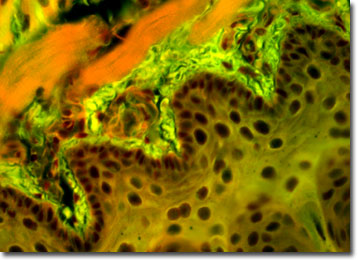Fluorescence Digital Image Gallery
Trichina Worm
Trichina (Trichinella spiralis) is a parasitic nematode worm that causes trichinosis, a serious disease in humans and other meat-eating mammals. A member of the phylum Aschelminthes, it ranges in length from 0.06 to 0.2 inches and has a nearly worldwide distribution.

The trichina worm lives inside the small intestine of a host animal, where it mates and reproduces. Once her eggs have been fertilized, the female burrows into the intestinal wall and releases her larvae. The larvae migrate into the lymph channels of the intestine, from which they enter the bloodstream and travel to all parts of the body. When the larvae reach the skeletal muscles they burrow into the muscles and form tough cyst-like cocoons. The host secretes lime salts, which are deposited in the capsule, eventually transforming the capsule into a completely calcified cyst. The worms may live in the cyst for years until they are consumed and digested by another mammal.
Once in the stomach, the capsular coating of the larvae dissolves, and they are freed. The larvae mature quickly, in about 16 days, and mate in the small intestine of their new host. If the larvae that live in the muscle tissues aren't eaten after several years, they will die and the cyst will completely calcify.
The most common way that humans become infected with trichinosis is by eating raw or undercooked pork. People can also become infected by eating wild game, such as bear, cougar, fox, dog, wolf, horse, seal, or walrus. Within a few days, the victim becomes feverish and experiences abdominal symptoms: pain, nausea, vomiting, and watery stools. A few days later the victim may still have pains in the joints, headaches, and swelling of the face. In addition, severe pain develops in the muscles of the limbs, in the chest, and in the eyes. Breathing is often painful because the diaphragm becomes heavily infected. The illness gradually subsides after seven to 14 days, although it can be fatal for about five percent of people. As of now, there is no known specific treatment for trichinosis, but it can be prevented. Trichina cysts in meat can be destroyed completely by thoroughly cooking the meat to 170° F (77° C) or by freezing the meat for three to four weeks. Cured or smoked pork is not safe for consumption.
The specimen presented here was imaged with a Nikon Eclipse E600 microscope operating with fluorite and/or apochromatic objectives and vertical illuminator equipped with a mercury arc lamp. Specimens were illuminated through Nikon dichromatic filter blocks containing interference filters and a dichroic mirror and imaged with standard epi-fluorescence techniques. Specific filters for the trichina worm stained thin section were a B-2E/C and a Y-2E/C. Photomicrographs were captured with an Optronics MagnaFire digital camera system coupled to the microscope with a lens-free C-mount adapter.
BACK TO THE FLUORESCENCE DIGITAL IMAGE GALLERY
